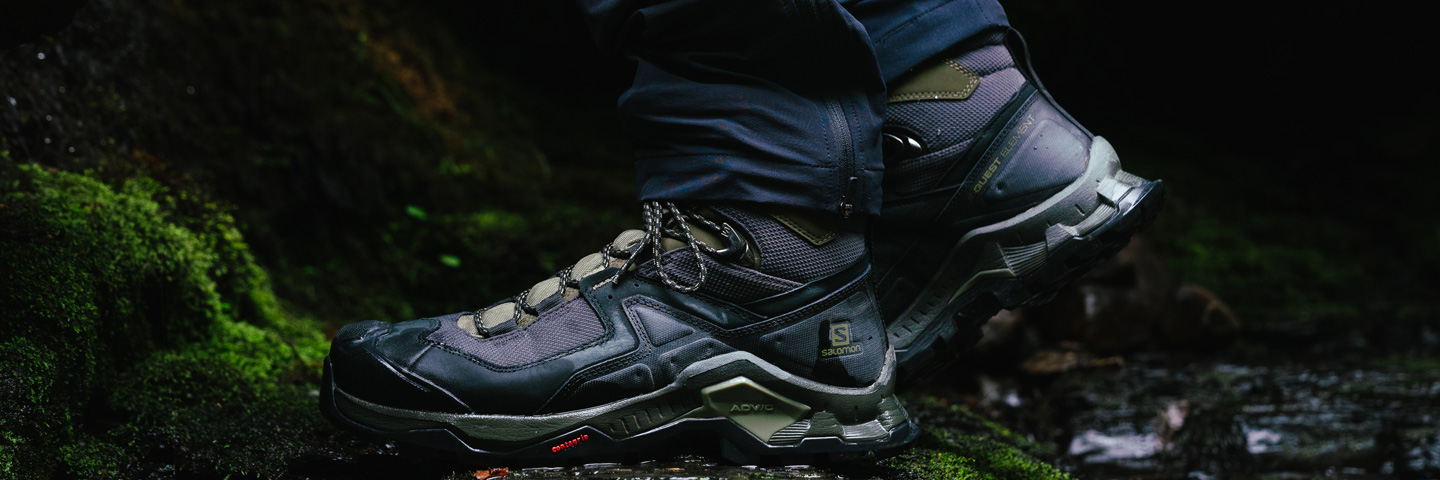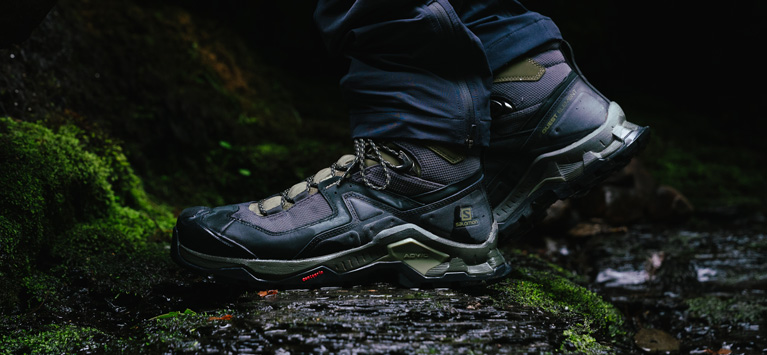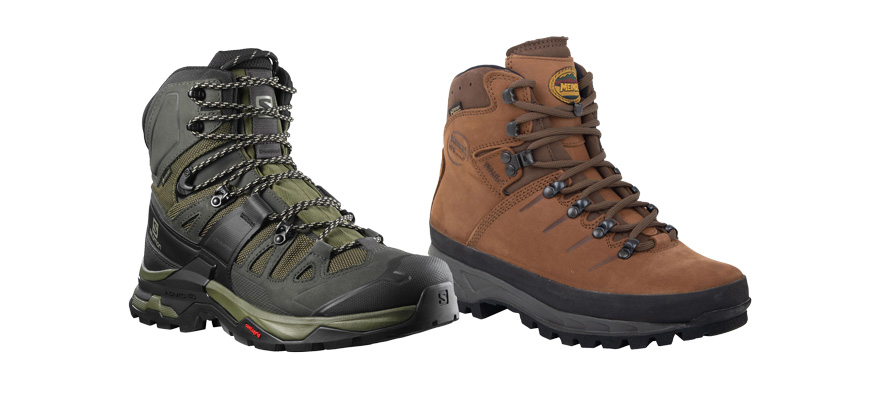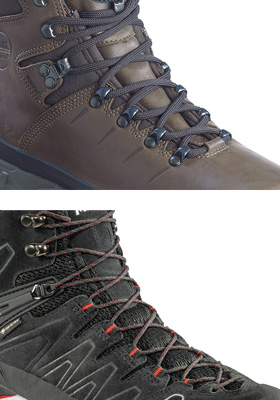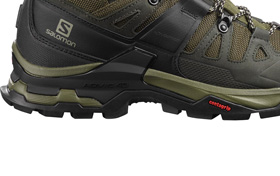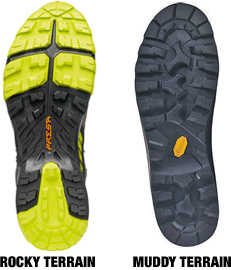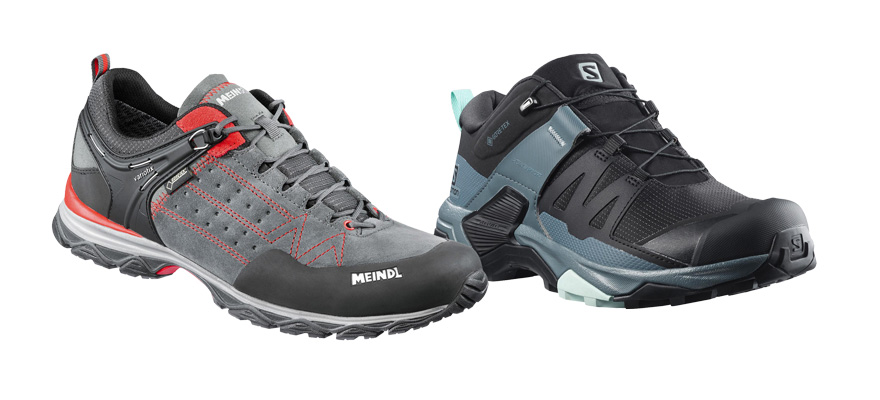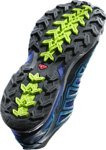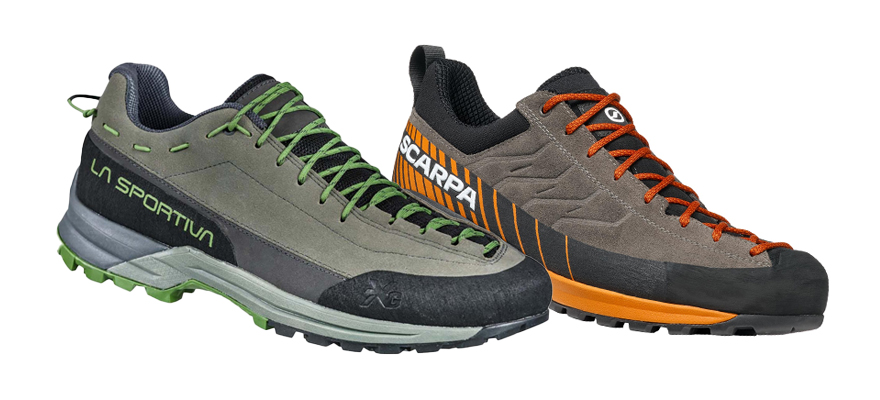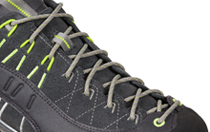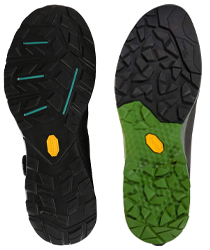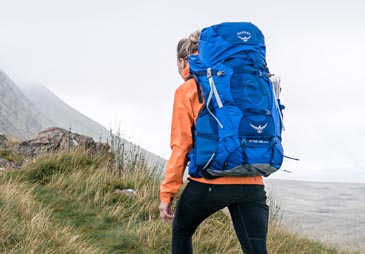Walking Footwear Buying Guide
When it comes to hill walking, few elements are as important as selecting the right walking boots or shoes for your adventures. With a huge collection of walking boots, walking shoes, and approach shoes available, it's important to know what you're looking for in your footwear, how it affects your experience on the trail, and how they should fit.
This guide is designed to help you make your selection so that you can enjoy the hills safe in the knowledge that your footwear is just right for your adventure.
Walking Boots
Perfect for: hill walking, wet weather, long distances, challenging terrain, carrying big packs
Key brands: Meindl, Scarpa, Salomon
Overview
Walking boots are the go-to option for most walkers. Sturdy and versatile, they can handle almost everything the British countryside can throw at them, from Lakeland scrambles to Cotswold meanders and all of the terrain in between.
Walking boots are usually:
- Waterproof and breathable
- Highly supportive over the ankle and through the midsole
- Well cushioned for impact absorption
- Highly durable
The Upper
The uppers of walking boots are built for support, with high over-the-ankle protection. Acting as the first line of defence against the elements, the upper part of a walking boot is usually made from either treated leather, synthetic fabric or a combination of both. Each has its own pros and cons.
- Leather boot uppers are sturdy, protective, and very supportive. They are perfect for use in the rugged British mountains and when looked after properly, they can last a very long time.
- Boots with synthetic uppers tend to be lighter weight and are incredibly breathable, making them ideal for summer walking and milder temperatures.
The tongue of a walking boot is usually gusseted, meaning it has a section of material on either side attaching the tongue to the rest of the boot. This acts as a guttering system, keeping water or any other elements from getting down the side of the tongue and into the boot.
The Liner
Most walking boots have a waterproof liner that still allows the shoe to be breathable. This prevents water from getting in but allows perspiration to escape through the upper fabric. Technologies such as GORE-TEX wick sweat through the upper and prove an unrivalled means of keeping your feet dry and comfortable on the trail. Some brands such as Keen use their own liner technology that offers similar performance.
The Midsole
Anatomically curved to match and support the natural shape of your foot, the midsole forms most of the impact protection and underfoot support. Midsoles can be made from a variety of materials. EVA (Ethylene vinyl acetate, more commonly known as expanded foam or foam rubber) is a popular choice as it is very lightweight and provides excellent cushioning, while some use PU (Polyurethane) for its perfect level of flex and support. Walking boot midsoles are usually made from a layering of both materials to find the perfect balance. The structure of the midsole defines the flex of the boot – the amount of movement between the forefoot and heel. Manufacturers will also include their own technologies to adjust the amount of flex and cushioning. A softer flex is great for easier trails and relaxed walking, while a stiffer midsole will be more suitable on more demanding routes involving tricky mountain terrain.
The Outsole
The sole of a walking boot is usually made from vulcanised rubber for its unrivalled grip and durability. Vibram is the most common brand of sole manufacturer, though there are alternatives, such as Salomon's Contagrip, and these perform equally well.
The depth and pattern of the lugs (the gripping teeth on the sole) have a direct effect on the walking boot's ability to perform in certain conditions. Boots with a chunkier tread (such as the boot on the right) will be more at home in muddy, slippery conditions and they shed mud easily. Those with a thinner pattern (such as the boot pictured left) will handle better on rocky terrain, with more surface area put in direct contact with the ground. Try and consider the terrain of your usual or upcoming routes and what you will encounter the most.
Perfect for: fast and light walks, warm drier weather, easy-going trail terrain
Key Brands: Salomon, Merrell, Meindl, Keen
Overview
Full walking boots can sometimes seem a little overkill, especially on short, flat routes or in warm, dry weather when you haven’t got a big rucksack on. Walking shoes are designed to provide a lightweight alternative, offering underfoot comfort and protection for routes when the terrain isn’t going to get too tough and ankle support isn't critical.
The Upper
As they're intended for milder weather, walking shoes are often made with synthetic fabric uppers. This keeps them much lighter and more breathable than shoes made entirely from leather, as well as making them instantly comfortable. This does mean that they don't offer quite the same weather protection as walking boots, so if your walks regularly involve deep puddles, torrential rain or stream crossings, bear this in mind.
The Liner
Like walking boots, most walking shoes will have a waterproof liner unless intended solely for dry, hot weather treks. There are a few technologies in use, but GORE-TEX is again typically the most popular. It is worth noting that although the membranes are waterproof, the lower ankle height makes walking shoes more susceptible to water entering over the top of the cuff when compared to a walking boot.
The Midsole
The midsole of a walking shoe is built to offer support, coupled with a comfortable flex and plenty of impact absorption. Both torsional and longitudinal flex will be more than found in a walking boot as walking shoes are not designed to handle too challenging terrain.
The Outsole
Walking shoe outsoles are built to handle a huge variety of terrain, but without the magnitude demanded of walking boots. Outsoles feature a finer patterned tread than walking boots, but deep enough to offer plenty of traction when the going underfoot gets a little slippy. This means they are superbly versatile.
Perfect for: short walks on rocky, technical terrain
Key brands: Scarpa, La Sportiva
Overview
As their name suggests, approach shoes are designed for the rocky approach to a climb. They provide a halfway house between walking and climbing shoes and are designed for grip and precision, making them ideal for short but tricky routes to the crags. Super-sticky, shallow patterned soles make for superb traction on all kinds of rock, while a low-cut ankle provides excellent mobility when the going gets a little more technical. While not intended for full–on rock climbing routes, they are great for scrambling and are incredibly versatile. But far from the niche technical aesthetic of climbing shoes, approach shoes have a much more relaxed, easy-to-wear appeal and make great casual shoes.
The Upper
The uppers on approach shoes are usually made from synthetic materials or nubuck leather, with a synthetic tongue for comfort and ventilation. The lacing system of an approach shoe typically extends down the foot further than those found on walking boots and shoes, and this provides precise adjustability and the close fit needed for scrambling or edging.
The Liner
Some approach shoes include a GORE-TEX liner for all-weather scrambles, but the majority are optimised for breathability on drier summer days.
The Midsole
As the midsole of a shoe defines its stiffness, approach shoes have to strike a very fine balance between stiff support for handling uneven terrain, and flex for sensitivity and underfoot precision on the rock. For this reason, the majority of approach shoes will use PU (Polyurethane) as the main component in midsole construction as it provides this optimal holy grail of rigid support and flex.
The Outsole
Approach shoes have super sticky outsoles made from fairly soft but abrasion-resistant rubber compounds making for superb traction on all kinds of rock. They'll tend to have a much shallower patterned tread than walking boots or walking shoes so that more of the sole can come into contact with the surface of the rock face for confidence when 'smearing' on the walk-in. While not designed to handle anything too technical, they often have a climbing zone at the front of the sole providing excellent precision when edging and scrambling en route to a climb, and many will have a varied pattern to handle muddier approaches as well. Like climbing shoes, approach shoes have a reinforced rand that offers solid protection against abrasion at the front of the shoe.
How Should Walking Footwear Fit?
Ensuring your walking footwear fits perfectly is crucial for comfort and performance, and for that reason we always recommend trying on in-store if possible. When first trying your footwear on, these are a few simple tests you can use to ensure the fit is correct:
- Make sure your toes aren't pressing the front of the boot/shoe. Your foot should feel secure, with no heel lift, but your toes should have some room for movement. Try squeezing a finger down behind your Achilles tendon with your toes pushed into the front. If you can manage it (just), then your boots/shoes are about the right length.
- Check the width. While the uppers of leather boots will soften a little with time, the midsole won't. The upper should be holding your foot in place and the midsole should cradle your foot at the edges almost perfectly. If it feels too narrow or wide at the ball of the foot, then consider a different option.
- Try your boots/shoes on in the afternoon. A day in the hills causes your feet to expand slightly - particularly in hot weather, so trying them in the afternoon will give you a more realistic idea of how they'll feel when you need comfort the most.
- Wear your boots/shoes around the house before taking them on a walk. It's crucial that you make sure your footwear fits perfectly, so wearing them around the house first allows you to ensure you have made the right choice and gives you the opportunity to change anything.
- Only use one pair of socks! Modern footwear is designed to be secure, warm, and breathable. Wearing multiple pairs of socks isn't necessary for a comfortable pair of boots/shoes and will only heighten the risk of blisters as the materials will rub against each other.

